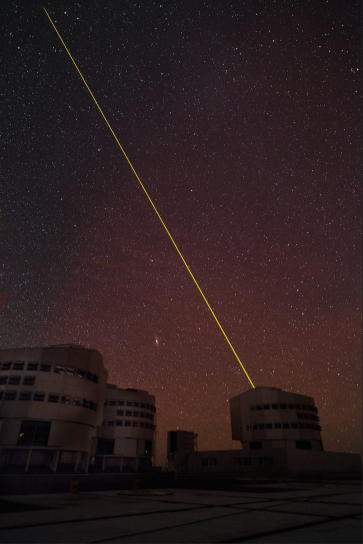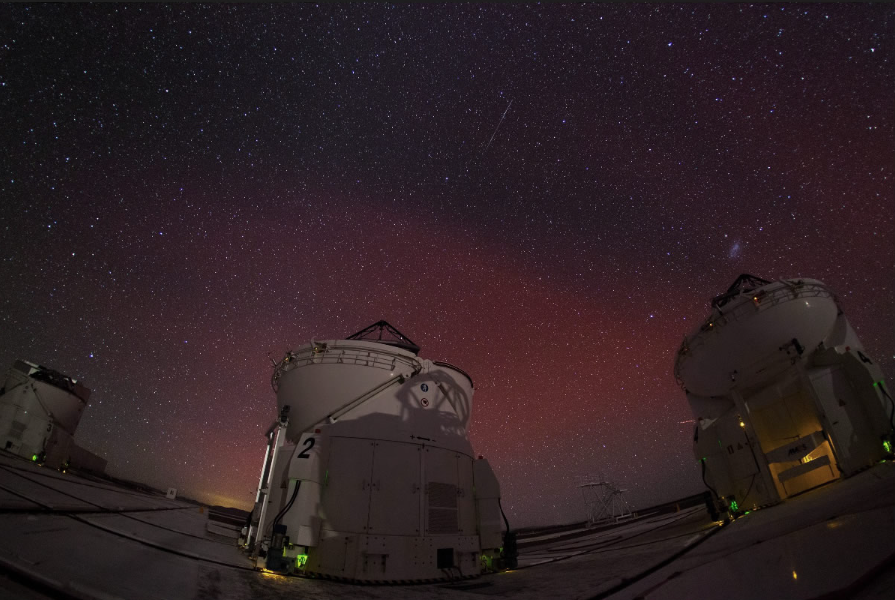OPOD - Airglow at Paranal Observatory
OPOD - Airglow at Paranal Observatory
At the Paranal Observatory in Chile, Yuri Beletsky captured stunning images of airglow phenomena. Paranal, which belongs to the European Southern Observatory, boasts advanced optical equipment, including four 8.2m telescopes and four auxiliary 1.8m telescopes that can be interconnected to form a powerful interferometer. Located in the Atacama Desert, the observatory was strategically chosen for its exceptionally dark and stable skies, allowing astronomers to peer deep into the universe.
However, even in such ideal conditions, the Earth's atmosphere is not completely devoid of light. Despite the absence of twilight and moonlight, a natural glow known as airglow can be observed. Airglow occurs when excited atoms and molecules emit light in the upper atmosphere, typically between altitudes of 85-300 km. This excitement is triggered by extreme ultraviolet radiation from the sun, while aurorae are caused by collisional excitation.
The most common color of airglow is green, as seen in one of Yuri's images. The green hue arises from forbidden transitions of oxygen atoms at altitudes of 90-100 km. Interestingly, Yuri also captured rare red airglow in his photographs. The origin of this crimson glow is believed to be vibrationally and rotationally excited OH radicals at an altitude of approximately 87 km. Additionally, oxygen atoms between 150-300 km may contribute to the formation of the red airglow.
In Yuri's images, the banded appearance of the airglow is evident. These bands result from the interaction between waves propagating up from the lower atmosphere and the competing processes of collisional de-excitation and radiative de-excitation that give rise to airglow.
The Paranal Observatory employs adaptive optics to enhance the performance of its telescopes. To achieve this, a yellow laser beam is projected upwards from the Yepun telescope, creating an artificial star in the upper atmosphere. This artificial star acts as a reference point for the adaptive optics system, allowing for precise adjustments to correct for atmospheric distortions and achieve clearer images.
Yuri's images also showcase the auxiliary telescopes at Paranal, which can be repositioned along railway tracks. These telescopes are optically linked to each other and the larger telescopes through mirrors and delay lines in underground tunnels. By combining their observations, these telescopes form a massive interferometer, enabling high-resolution imaging and increased light-gathering capabilities.
In conclusion, the Paranal Observatory provides astronomers with an exceptional platform for studying celestial objects. Despite the best efforts to minimize light pollution and take advantage of the darkest skies on Earth, airglow remains a fascinating phenomenon that adds its own unique glow to the observatory's images. Yuri Beletsky's photographs beautifully capture the interplay of colors and bands of airglow, reminding us of the dynamic nature of our atmosphere and the wonders it holds.

Airglow, Paranal Observatory
Yuri Beletsky took this image and those below at Paranal, Chili. Paranal, part of the European Southern Observatory, is the world’s most advanced optical observatory with four 8.2m and four auxiliary 1.8m telescopes that can be optically linked into a giant interferometer.
The site, high in the Atacama Desert was chosen for its ultra-dark and steady skies but Earth’s skies are rarely completely dark. Take away the last vestiges of twilight, take away moonlight, try to evade the pollution of thoughtlessly bright and unshielded artificial lights and we find that sometimes the upper atmosphere itself glows – airglow.
Fortunately for astronomy the brightness of the red airglow in these pictures was exceptional.
Airglow is light emitted by excited atoms and molecules 85-300 km high in the atmosphere. The excitation derives from extreme ultra violet radiation from the sun (aurorae are collisionally excited). Green is the most common airglow colour, see Yuri's third image below. The less common red airglow is probably from vibrationally and rotationally excited OH radicals in a band 87 km high. Oxygen atoms at 150 – 300 km might also have formed it.
The airglow at left is banded. Waves propagating up from the lower atmosphere influence collisional de-excitation that competes with the airglow-forming radiative de-excitation.
A yellow laser beam shines up from the Yepun telescope to create an artificial star in the upper atmosphere that controls the telescope's adaptive optics.
All images ©Yuri Beletsky, shown with permission.

Red (upper image) and green (lower picture) airglow over Paranal's 1.8m auxiliary telescopes. The fainter green airglow near the horizon represents the 'normal' sky over the Atacama Desert. The green comes from forbidden transitions ( O1S to 1D ) of oxygen atoms 90-100 km high in a band that is easily visible from earth orbit. The yellow patch in the upper image is light pollution from a copper mine 200km away. In the lower image, satellite galaxies, the Large and Small Magellanic Clouds blaze in the sky and at left is an upside-down Orion
Paranal's four auxiliary telescopes can re-locate on railway tracks and are optically linked to each other and the four large telescopes via mirrors and delay lines in underground tunnels. They form a giant interferometer with high resolving power and light gathering ability.

Note: this article has been automatically converted from the old site and may not appear as intended. You can find the original article here.
Reference Atmospheric Optics
If you use any of the definitions, information, or data presented on Atmospheric Optics, please copy the link or reference below to properly credit us as the reference source. Thank you!
-
<a href="https://atoptics.co.uk/blog/opod-airglow-at-paranal-observatory/">OPOD - Airglow at Paranal Observatory</a>
-
"OPOD - Airglow at Paranal Observatory". Atmospheric Optics. Accessed on December 25, 2024. https://atoptics.co.uk/blog/opod-airglow-at-paranal-observatory/.
-
"OPOD - Airglow at Paranal Observatory". Atmospheric Optics, https://atoptics.co.uk/blog/opod-airglow-at-paranal-observatory/. Accessed 25 December, 2024
-
OPOD - Airglow at Paranal Observatory. Atmospheric Optics. Retrieved from https://atoptics.co.uk/blog/opod-airglow-at-paranal-observatory/.